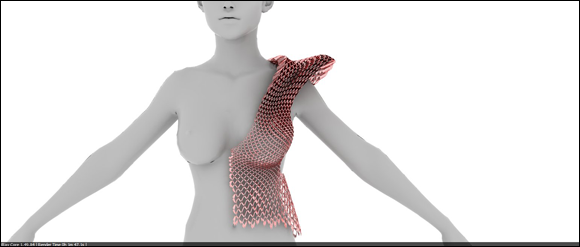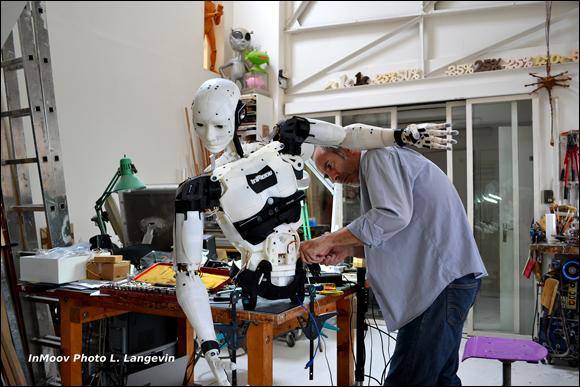Chapter 17
Ten Examples of Direct Digital Manufacturing and Personalization
Additive manufacturing isn’t a futuristic technology; it’s already in place and in use across many industries. Created for rapid prototyping, additive manufacturing has steadily migrated into direct digital fabrication of consumer products. As material options expand and the complexity of 3D-printed objects increases to include integrated electronics and enhanced structural designs, a broader spectrum of products can be manufactured directly from electronic files and raw source materials. This chapter discusses ten examples of this type of direct digital manufacturing.
Producing 3D-Printed Food
Cornell University and other research sites are exploring 3D-printed foods such as vegetable wafers and meat pastes. Under a NASA grant, a small company in Austin, Texas, is working on a 3D printer that will use materials from long-shelf-life powders, suspended oils, and water to create pizzas that will cook to completion on the heated build plate of the printer. Future astronauts will depend on such systems to prepare food during long-term travel to Mars and beyond. Other researchers are demonstrating the use of lab-grown meat cells to create 3D-printable hamburgers and steaks that don’t require raising and feeding animals. These developments will start to provide alternative options for food production and could significantly improve animal welfare and overall food quality. Also, this technology may one day provide travelers and explorers practical, portable supplies and allow sufficient protein consumption even in the absence of farms. Cornell’s students already print custom cakes and finger foods using a growing range of ingredients that have been prepared for a paste extrusion process.
Printing Tissues and Organs
Beyond the simple biological materials needed to print muscle tissues and foodstuffs, additive manufacturing bioprinters are being developed to create complex multicellular matrices that can grow into functional organs and replacement tissues for human recipients. One benefit of these designs is that they can use a recipient’s own cells, producing implantable replacements that don’t require a lifetime regimen of immunosuppressive medications to prevent transplant rejection.
One example of this type of printing is 3D-printed fine sugar strands in a complex multidimensional array suspended in culture gels. After printing, the sugar is dissolved; then fluids similar to blood are circulated inside the structure to allow for growth and nourishment of the cells. For example, these cells may be a framework into which bladder cells can grow. Currently, complex critical organs such as multicellular livers are being tested. Also, small 3D-printed samples of different types of organs are being used to test new pharmaceuticals and medical treatment protocols outside living bodies.
Fashioning Biological Replicas
Until bioprinters can create replacement living tissues, 3D printing has a promising medical role, because it allows the fabrication of prostheses and implants perfectly matched to the original body part (or mirrored from functional body parts). Gone are the days of crude wooden peg legs and articulated hooks for missing limbs. A prosthesis can be transformed through 3D printing into not only a functional replacement, but also a work of art that accurately reflects the wearer’s personality.
Companies such as Open Bionics are making great progress in low-cost replacement limbs. The Ada bionic hand, as shown in Figure 17-1, is a fully functional open-source robotic hand. The Ada hand uses low-cost electronics and actuators along with plastic components that can be produced on a desktop 3D printer. Anyone can print and assemble this bionic hand then control it via a USB link to a computer.

Image courtesy of Open Bionics
FIGURE 17-1: The Ada bionic hand from Open Bionics.
The company’s original products were 3D-printed but used mechanical action to activate the closure of fingers to grip an object. In recent years, Open Bionics has developed electronically activated, user-controlled hands like Ada. This technology isn’t new, but 3D printing ensures a perfect fit for every user at a lower cost and faster production speed than existing casting methods can provide — especially important for children, whose prosthetic devices need to be changed regularly during growth.
Crafting Clothing and Footwear
3D printing allows the creation of textiles and other clothing. One such product is custom-fit athletic wear that provides better traction and reduced weight. Another product is clothing uniquely tailored to each wearer’s measurements (see Figure 17-2). Even if two people wore the same dress to a ball, the dress would appear to be two different creations suited to each wearer.

Image courtesy of the Francis Bitonti Studio
FIGURE 17-2: Ensuring a precise fit for a gown by mapping the design to the wearer’s measurements.
Researchers are also developing ways to spray material fibers in three dimensions directly on a 3D-printed pattern form. This process, combined with subsequent steps to soften the material, can produce an item like a T-shirt without any stitching or assembly required.
Customizing Jewelry
Among the earliest small 3D-printed items were customized plastic earrings and pendants. Today, industrial 3D-printing processes can produce solid forms in various metals, including titanium, brass, and bronze. The most difficult metal to 3D print is gold because it reflects 90% of the laser beam's energy, making sintering of the gold powder extremely challenging. Gold 3D printing is available from select suppliers, but it also costs several hundred thousand dollars to fill a machine with enough gold powder to make the process economically viable. Individual designers can now use many online 3D-printing service providers to 3D print custom jewelry in many different materials. As desktop 3D printers produce smaller and more detailed objects, producing and customizing intricate artworks will be even more accessible to individual designers.
Making Hollywood Spectacular
Model makers have long created sets and props for movie productions. 3D printing makes it possible to custom-fit a costume to an actor. It's now common practice to use 3D printing in almost every aspect of film and TV production. For the stop-motion film The Pirates! Band of Misfits, Aardman Studios 3D printed all interchangeable parts of the main characters, which amounted to more than 20,000 interchangeable heads to accommodate the many emotions and facial features used during production. Full-color models can be 3D printed directly, but it's still more common to use 3D printing for rapid production of the model, while a team of painters finish each part by hand. Using 3D printing is really now the only way reduce both time and costs for production companies that require custom costumes or thousands of slightly differing parts.
Creating Structures
3D printing can produce structures big enough to live in. This technology will enable astronauts to fashion habitats and satellites in space, using materials derived from asteroids and other sources rather than carrying materials from Earth at great cost.
Eventually, entire houses on Earth will be crafted in place. Right now, 3D-printed concrete modules are being used to repair denuded reefs and other damaged elements of the ecosystem. Researchers at the University of Washington and in Europe are testing systems aimed at scaling up printers so that they can craft entire buildings.
Reaching beyond the Sky
Designs for high-performance turbines and jet-engine compressor blades can be created as single-print objects rather than traditional assemblies of smaller components. 3D printing can bring a significant advantage in the reduction of component parts. 3D-printed components that are built with a layer-by-layer process can be more complicated than parts that require the use of subtractive machining process. Having fewer parts to join in an assembly can reduce weakness and often overall weight of the product. For an aircraft, that can be a significant saving and can reduce the possibility of mechanical failure.
General Electric is taking advantage of this capability by updating designs during the production cycle simply by changing the files used to fabricate jet-engine components. NASA has successfully tested 3D-printed rocket nozzles and other high-pressure components needed to let aircraft and spacecraft slip “the surly bonds of earth” (as John Gillespie Magee, Jr. wrote in his poem “High Flight”). As private industry begins to join with governments in the exploration of space, we will see the use of additive manufacturing play a significant role in cost reduction and design iteration.
Constructing Robots
Automation and robotics are transforming the world into a highly interactive, self-controlling environment. Factories once filled with hundreds of workers exposed to hazardous environments are now automated and managed from positions of relative safety by remote operators. The tools used for these purposes are often custom-built designs, but 3D printers enable small runs of custom robotics suited to a purpose too narrow to draw the attention of large industries. Complex linkages and connections can be easily created on 3D printers to form one-off brackets and other elements to fit the need at hand. Innovations can be added and tested easily to enhance the capability of robots.
As artificial intelligence continues to grow, personal mobile robots may perform many physical tasks. The open-source community is creating almost life-size humanoid robots, developed in the open-source community, using 3D printers to produce the main structural and motion elements (see Figure 17-3). Advanced microelectronics and battery capacity still have a long way to go, however, before fully bipedal robots operate for more than a few hours at a time.

Image courtesy of L. Langevin; http://inmoov.fr/
FIGURE 17-3: The InMoov 3 printed humanoid project in construction.
Printing 3D Printers
3D printers make it possible to fashion more 3D printers by using basic robotic controls and linkages together with custom brackets and common off-the-shelf hardware. When fundamental patents on fused deposition modeling (FDM)/fused filament fabrication (FFF) thermoplastic extrusion expired in 2006, Dr. Adrian Bowyer’s Self-Replicating Rapid Prototyper (RepRap) project was released as an open-source design, and a capability once open only in labs and high-end manufacturing facilities became available in a household appliance that cost less than the first LaserJet printers. Thousands of RepRaps and their offspring are available today in maker spaces, schools, and office-supply stores. Each printer can print many of the components for another printer in turn, using open-source designs that are freely available online.
More possibilities await as additional fundamental patent controls expire in the coming decades. The original stereolithographic (SLA) technology, for example, has fallen out of patent protection and is being used in systems such as the Form 2 Selective laser sintering (SLS) patents expired in 2014, opening commercial and hobbyist opportunities by making personal fabrication possible for plastics, metals, ceramics, and other granular-powder materials. Companies such as Sharebot in Italy are making SLS systems for a fraction of the cost of the systems used just ten years ago.
Metal sintering has requirements that are slowing its wider adoption, such as environmental controls, specialized gasses, and high-powered lasers that require special enclosures to protect their users. Granted, metal sintering is more complex, elaborate, and costly than FDM/FFF thermoplastic printers and resin-based SLA printer.
